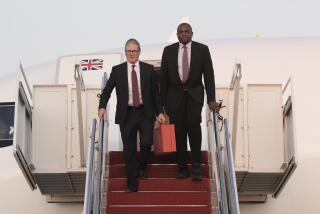Superpower Arms Summit Planned : Nuclear weapons: Bush, Gorbachev will meet early next year to sign a treaty to reduce strategic arsenals.
- Share via
PARIS — President Bush and Soviet President Mikhail S. Gorbachev will hold a summit meeting early next year in Moscow, where they expect to sign a long-awaited strategic arms reduction treaty, U.S. and Soviet officials announced Tuesday.
The START accord, the subject of intense negotiations since 1982, will eliminate fully one-third of the two nuclear superpowers’ long-range weapons.
Revolutionary political changes in the Soviet Union have dramatically reduced the threat of nuclear confrontation, but Bush has been eager to nail down the START reductions while Gorbachev remains in power and strong enough to conclude such an agreement.
For his part, Gorbachev has seen START as a critical element in freeing the crippled Soviet economy from the financial burdens of the Cold War. And Moscow has made most of the major concessions that have moved negotiations forward over the last two years.
To clinch the accord in time for the next summit, the two sides are understood to have agreed to split the difference on a short list of remaining issues. These include limits on the Soviet Backfire bomber and SS-18 missiles and on the transfer of U.S. nuclear weapons technology to Britain.
A final meeting between Secretary of State James A. Baker III and Soviet Foreign Minister Eduard A. Shevardnadze is planned next month in Washington to wrap up details on verification measures for the treaty.
Bush and Gorbachev agreed to the new Moscow meeting during their dinner meeting Monday night, Soviet spokesman Vitaly N. Ignatenko said.
As part of the same trip, Bush is expected to visit Turkey and Greece. Turkey is a front-line state in the confrontation with Iraq over Kuwait, and the historic tension between Greece and Turkey make it a diplomatic necessity that an American President visiting one must also visit the other.
The START, or strategic arms reduction talks, were broken off by the Soviets in 1983, a year after they began, in protest over U.S. medium-range missile deployments in Europe. They did not resume until 1985.
Although preceded by two earlier accords, SALT I and SALT II, the START treaty will be the first to require the actual reduction of weapon systems that each superpower has in place and aimed at the other one. SALT I and SALT II set ceilings on strategic weapons, but in each case the ceilings were higher than the existing arsenals so that neither side had to destroy weapons.
The initial goal for START was to cut existing arsenals in half, but several loopholes have been built into the treaty. In the end, the number of the most dangerous and destabilizing weapons of the Soviet Union--land-based intercontinental missiles--will be cut in half, but the overall reductions will be more like 30% of the stockpiles on each side.
In particular, each side will be limited to 1,600 delivery systems--missiles and heavy bombers--and to 6,000 “accountable” warheads. Of these, 4,900 warheads can be on ballistic missiles, with the rest on bombers.
The accounting system, however, permits bombers to carry as many nuclear bombs and short-range nuclear missiles as they can, but they will only be counted as one “accountable” warhead. If air-launched cruise missiles are carried, U.S. bombers will count as 10 warheads although they can actually load 20 ALCMs, and Soviet bombers count as eight even if they carry their maximum load of 12.
These rules, largely devised by the Pentagon and accepted by Moscow, were implemented because bombers and ALCMs are slower-moving weapons against which defenses exist. Besides being vulnerable, they are considered to be mainly retaliatory weapons, rather than surprise attack weapons.
But the rules mean that the current arsenals of 12,000 to 13,000 weapons will only be reduced to 8,000 to 9,000 weapons, not 6,000, when the treaty is fully implemented in seven years.
Several of the major sticking points have been resolved, mostly since Gorbachev took office and mostly because of Soviet concessions.
In particular, the clash over “Star Wars” anti-missile defenses ended when the Soviets agreed in 1988 to drop their previous insistence that space defenses be linked to the START treaty on offensive weapons. The Soviets will now simply issue a statement, presumably stating that the building of a “Star Wars” shield could jeopardize the START treaty, but it will not be part of the treaty itself.
In the final days of negotiations, the three outstanding issues appeared more related to political concerns than military factors:
* Soviet Backfire bombers, which Moscow insists are medium-range weapons and the United States claims can be long-range weapons, will be limited in a separate binding statement. Washington wanted the ceiling to be 400 aircraft, the Soviets wanted a 600-plane limit, and they settled on 500.
* Soviet SS-18 intercontinental missiles, which are the biggest and most threatening weapons, will be limited in various marginal ways. But the Soviets retained the right to modernize them and flight-test the new models, although they cannot build any new missiles of the same size.
* The longstanding U.S. cooperative arrangement with Britain in nuclear weaponry will be essentially unchanged. Moscow eventually gave up its attempts to limit U.S. technological help for Britain’s Trident submarines and ballistic missiles.
More to Read
Sign up for Essential California
The most important California stories and recommendations in your inbox every morning.
You may occasionally receive promotional content from the Los Angeles Times.













